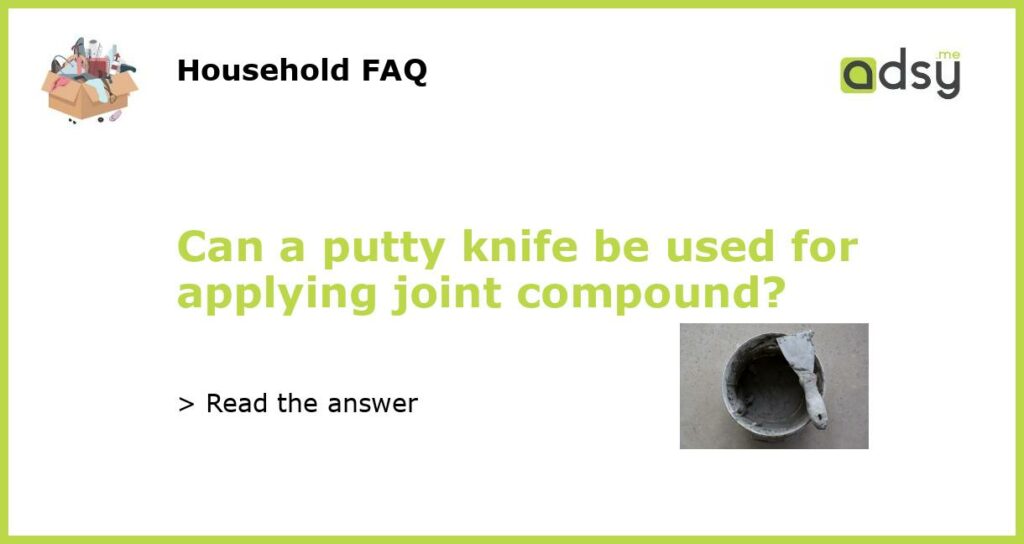Can a putty knife be used for applying joint compound?
When it comes to applying joint compound, there are a variety of tools available, and one commonly used tool is a putty knife. Putty knives are versatile tools that can be used for a range of applications, including applying joint compound. However, there are a few factors to consider when deciding whether a putty knife is the right tool for the job.
The benefits of using a putty knife for applying joint compound
Putty knives are popular among DIYers and professionals alike for applying joint compound due to several benefits they offer.
First, putty knives are affordable and readily available at most hardware stores. This makes them an accessible tool for anyone looking to tackle a home improvement project.
Second, putty knives come in a variety of sizes, allowing for flexibility in application. From narrow blades for precise work to wider blades for covering larger areas, putty knives offer options depending on the scope of the project.
Additionally, putty knives are easy to clean and maintain. After each use, simply wipe them down with a cloth and remove any excess joint compound. This makes putty knives a convenient tool for those working on multiple projects or who need to clean up quickly.
Overall, putty knives provide a cost-effective, versatile, and easy-to-use option for applying joint compound.
Considerations when using a putty knife for applying joint compound
While putty knives can be effective for applying joint compound, there are a few considerations to keep in mind.
First, the size of the putty knife should be appropriate for the task at hand. For larger areas, a wider putty knife will allow for quicker application, while a narrower blade will be more suitable for detailed work or tight spaces.
Second, the flexibility of the putty knife can affect the ease of application. Stiffer blades may require more pressure to spread the joint compound, while more flexible blades can provide a smoother and easier application.
Lastly, the handle design of the putty knife should be comfortable and ergonomic. This will make the application process more efficient and reduce fatigue during long periods of use.
Considering these factors will ensure that a putty knife is used effectively for applying joint compound.
Alternatives to a putty knife for applying joint compound
While a putty knife can be a suitable tool for applying joint compound, there are also alternative options available.
One common alternative is a drywall taping knife. These knives are specifically designed for applying joint compound to drywall seams and corners. They typically have a wider and more flexible blade than a putty knife, making them ideal for larger projects.
Another option is the use of a hawk and trowel. A hawk is a square platform with a handle, while a trowel is a flat rectangular blade. This combination allows for efficient application and manipulation of joint compound. Highly skilled professionals often prefer this method for its precision and control.
It’s important to evaluate the specific needs of the project and choose the appropriate tool for the job. Consulting with professionals or researching online resources can provide further guidance in selecting the best tool for applying joint compound.
Proper technique for applying joint compound with a putty knife
To achieve the best results when using a putty knife for applying joint compound, it’s essential to follow proper technique.
First, ensure that the blade of the putty knife is clean and free from any debris or dried compound. This will prevent any unintended textures or marks in the fresh compound.
Next, load the putty knife with a small amount of joint compound. Using the flat side of the blade, apply the compound evenly to the desired area, moving the putty knife in a smooth, consistent motion.
As you work, periodically wipe the excess compound from the putty knife to maintain a clean and smooth application. This will prevent any buildup of dried compound, which can affect the finish of the joint compound.
Finally, after the joint compound has dried, sand the area lightly with fine-grit sandpaper to smooth any imperfections. This will create a seamless finish for painting or further treatment of the surface.
While a putty knife can be used for applying joint compound, it’s essential to consider the size, flexibility, and handle design of the knife. Alternatives such as drywall taping knives or a hawk and trowel may be more suitable for specific projects. Following proper technique, regardless of the tool used, will ensure a smooth and professional finish for your joint compound application.






